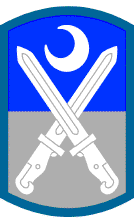218th Maneuver Enhancement Brigade (United States)
| 218th Maneuver Enhancement Brigade | |
|---|---|
|
218th Maneuver Enhancement Brigade shoulder sleeve insignia | |
| Country | United States |
| Allegiance | United States Army |
| Branch | United States Army National Guard |
| Type | Maneuver Enhancement |
| Size | Brigade |
| Commanders | |
| Current commander | Colonel Waymon B. Storey |
The 218th Maneuver Enhancement Brigade is a maneuver enhancement brigade of the United States Army National Guard of South Carolina. It formerly was a heavy brigade combat team. As an ME brigade, it will control a mix of engineer, military police and chemical units.
History
The 218th Infantry Brigade (Heavy Separate) was the largest major subordinate command in South Carolina. It was one of the fifteen Enhanced Readiness Brigades in the Army National Guard. Enhanced Readiness Brigades were the highest priority combat formations in the National Guard. It was previously the 2nd Brigade, 30th Infantry Division, from 1968 to 1974.[1]
Congressman John Spratt secured $100 million in funding in 1997 and 1998 to upgrade M2A2 Bradley Fighting Vehicles for the 4th Battalion,(Re-numberd to 1st Battalion in 2008) 118th Infantry Regiment, which is headquartered in Newberry and has companies in Union, Chester, Fountain Inn, Winnsboro, and Gaffney. For his staunch support of the National Guard, the National Guard Association of the United States awarded Congressman John Spratt one of its highest honors, the Charles Dick Medal of Merit. In accepting, Spratt said his support for the Guard comes naturally, because he knows so many "first-rate citizen-soldiers" who serve in the South Carolina National Guard. Spratt views the Guard as a cost-effective way of keeping combat-ready forces. But for the Guard to be combat-ready, he believes its units have to be on parity with their parent units in the regular Army when it comes to weapons and equipment.
Significantly, Congressional initiatives in 1997 and 1998 accelerated this Brigade's modernization by programming defense dollars for upgrading its Bradley Infantry Fighting Vehicles from the M2A0 model to the M2A2 model that provides enhanced crew protection and capabilities. The Brigade's tanks (M1A1 Abrams) were already on a par with those used by the active Army. The Brigade's artillery battalion is programmed for modernization in 2001.
The 218th was one of three Army Guard enhanced maneuver brigades that comprise the Army's 24th Infantry Division, headquartered at Fort Riley, Kansas, that was reactivated in June 1999 as a headquarters element for separate ARNG brigades. The two other brigades were located in North Carolina and Georgia. Nearly 10 years after the Persian Gulf War, the 218th was part of Army's new 'integrated' 24th Infantry Division, which in its previous life helped liberate Kuwait. It was considered an example of how closely active and reserve components are now working together.
For the 218th, the weeks of July 2000 were crucial. The soldiers spent two years preparing for their unit's first full-scale training rotation in southern California. There is no better way to replicate the fog of war than at the National Training Center. The brigade, supported by nearly 2,000 more citizen-soldiers in the Palmetto State Task Force, trained in many ways to pull off what was said to be the largest peacetime deployment of National Guard forces in history. More than $21 million was budgeted for the entire exercise, South Carolina Guard officials reported. Although South Carolina has fielded the bulk of the force, citizen-soldiers and airmen from 26 other states were engaged in the cross-country mission that will ended 30 July 2000. More than 1,800 tanks, armored fighting vehicles and other pieces of equipment were hauled from South Carolina to California on railroad cars and trucks. Seven Apache attack helicopters were flown down from Idaho to beef up the brigade's 373-soldier aviation task force. Still other helicopters were flown from the East Coast on C-5 cargo planes. The vast array of ground vehicles were unloaded in Yermo, California, and convoyed across the desert to Fort Irwin for two weeks.
The leadership of the 218th Brigade were activated immediately after 9/11 to control all of homeland security east of the Mississippi River. While many soldiers were activated along with their leaders to work in airports, sea ports, and other locations vital to national security, the units of the 218th were assigned to other National Guard brigades and Regular Army units in a piecemeal fashion for peacekeeping missions in Bosnia and Kosovo, as well as the war efforts in Iraq and Afghanistan.
Once the brigade had completed all of those missions, it was activated as a whole to take over Task Force Phoenix in Afghanistan in 2007.
In recent years the 218th Infantry Brigade was reorganized and redesignated as the 218th Maneuver Enhancement Brigade.
Awards
National Defense Service Streamer
Southwest Asia Service Streamer
Afghanistan Campaign Streamer w/ 1 bronze star
Global War on Terrorism Service Streamer
 NATO ISAF Medal Streamer
NATO ISAF Medal StreamerSC Governor's Unit Citation Streamer
External links
- ↑ McGrath, The Brigade, 240.
